Sulodexide attenuates endoplasmic reticulum stress induced by myocardial ischaemia/reperfusion by activating the PI3K/Akt pathway
- PMID: 31120192
- PMCID: PMC6653332
- DOI: 10.1111/jcmm.14367
Sulodexide attenuates endoplasmic reticulum stress induced by myocardial ischaemia/reperfusion by activating the PI3K/Akt pathway
Abstract
Acute myocardial ischaemia/reperfusion (MI/R) injury causes severe arrhythmias with a high rate of lethality. Extensive research focus on endoplasmic reticulum (ER) stress and its dysfunction which leads to cardiac injury in MI/R Our study evaluated the effects of sulodexide (SDX) on MI/R by establishing MI/R mice models and in vitro oxidative stress models in H9C2 cells. We found that SDX decreases cardiac injury during ischaemia reperfusion and decreased myocardial apoptosis and infarct area, which was paralleled by increased superoxide dismutase and reduced malondialdehyde in mice plasm, increased Bcl-2 expression, decreased BAX expression in a mouse model of MI/R. In vitro, SDX exerted a protective effect by the suppression of the ER stress which induced by tert-butyl hydroperoxide (TBHP) treatment. Both of the in vivo and in vitro effects were involved in the phosphatidylinositol 3-kinase (PI3K)/Akt signalling pathway. Inhibition of PI3K/Akt pathway by specific inhibitor, LY294002, partially reduced the protective effect of SDX. In short, our results suggested that the cardioprotective role of SDX was related to the suppression of ER stress in mice MI/R models and TBHP-induced H9C2 cell injury which was through the PI3K/Akt signalling pathway.
Keywords: PI3K/Akt; endoplasmic reticulum stress; myocardial ischaemia / reperfusion; sulodexide.
© 2019 The Authors. Journal of Cellular and Molecular Medicine published by John Wiley & Sons Ltd and Foundation for Cellular and Molecular Medicine.
Conflict of interest statement
The authors confirm that the content of this article has no conflicts of interest.
Figures


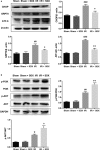
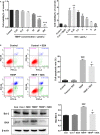
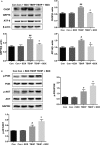
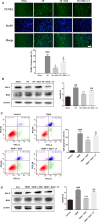
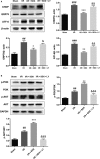
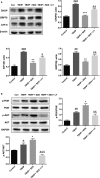
Similar articles
-
bFGF attenuates endoplasmic reticulum stress and mitochondrial injury on myocardial ischaemia/reperfusion via activation of PI3K/Akt/ERK1/2 pathway.J Cell Mol Med. 2015 Mar;19(3):595-607. doi: 10.1111/jcmm.12346. Epub 2014 Dec 23. J Cell Mol Med. 2015. PMID: 25533999 Free PMC article.
-
Melatonin reduces PERK-eIF2α-ATF4-mediated endoplasmic reticulum stress during myocardial ischemia-reperfusion injury: role of RISK and SAFE pathways interaction.Apoptosis. 2016 Jul;21(7):809-24. doi: 10.1007/s10495-016-1246-1. Apoptosis. 2016. PMID: 27170343
-
Tournefolic acid B, derived from Clinopodium chinense (Benth.) Kuntze, protects against myocardial ischemia/reperfusion injury by inhibiting endoplasmic reticulum stress-regulated apoptosis via PI3K/AKT pathways.Phytomedicine. 2019 Jan;52:178-186. doi: 10.1016/j.phymed.2018.09.168. Epub 2018 Oct 2. Phytomedicine. 2019. PMID: 30599897
-
MicroRNA-specific therapeutic targets and biomarkers of apoptosis following myocardial ischemia-reperfusion injury.Mol Cell Biochem. 2024 Oct;479(10):2499-2521. doi: 10.1007/s11010-023-04876-z. Epub 2023 Oct 25. Mol Cell Biochem. 2024. PMID: 37878166 Review.
-
The cardioprotective effects of hydrogen sulfide by targeting endoplasmic reticulum stress and the Nrf2 signaling pathway: A review.Biofactors. 2021 Sep;47(5):701-712. doi: 10.1002/biof.1763. Epub 2021 Jun 23. Biofactors. 2021. PMID: 34161646 Review.
Cited by
-
Up-regulation of PERK/Nrf2/HO-1 axis protects myocardial tissues of mice from damage triggered by ischemia-reperfusion through ameliorating endoplasmic reticulum stress.Cardiovasc Diagn Ther. 2020 Jun;10(3):500-511. doi: 10.21037/cdt-20-126. Cardiovasc Diagn Ther. 2020. PMID: 32695629 Free PMC article.
-
Extracellular Vesicles Derived from Human Umbilical Cord Mesenchymal Stromal Cells Protect Cardiac Cells Against Hypoxia/Reoxygenation Injury by Inhibiting Endoplasmic Reticulum Stress via Activation of the PI3K/Akt Pathway.Cell Transplant. 2020 Jan-Dec;29:963689720945677. doi: 10.1177/0963689720945677. Cell Transplant. 2020. PMID: 32864999 Free PMC article.
-
The Preventive and Therapeutic Effects of Acute and Severe Inflammatory Disorders with Heparin and Heparinoid.Biomolecules. 2024 Aug 28;14(9):1078. doi: 10.3390/biom14091078. Biomolecules. 2024. PMID: 39334845 Free PMC article. Review.
-
PHLDA3 inhibition attenuates endoplasmic reticulum stress-induced apoptosis in myocardial hypoxia/reoxygenation injury by activating the PI3K/AKT signaling pathway.Exp Ther Med. 2021 Jun;21(6):613. doi: 10.3892/etm.2021.10045. Epub 2021 Apr 14. Exp Ther Med. 2021. PMID: 33936270 Free PMC article.
-
Elevating miR-378 strengthens the isoflurane-mediated effects on myocardial ischemia-reperfusion injury in mice via suppression of MAPK1.Am J Transl Res. 2021 Apr 15;13(4):2350-2364. eCollection 2021. Am J Transl Res. 2021. PMID: 34017394 Free PMC article.
References
-
- Monassier JP. Reperfusion injury in acute myocardial infarction. From bench to cath lab. Part I: basic considerations. Arch Cardiovasc Dis. 2008;101:491‐500. - PubMed
-
- Penna C, Perrelli MG, Tullio F, et al. Diazoxide postconditioning induces mitochondrial protein S‐nitrosylation and a redox‐sensitive mitochondrial phosphorylation/translocation of RISK elements: no role for SAFE. Basic Res Cardiol. 2013;108:371. - PubMed
Publication types
MeSH terms
Substances
LinkOut - more resources
Full Text Sources
Research Materials

